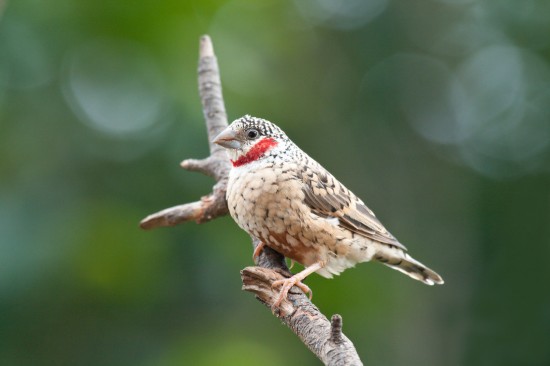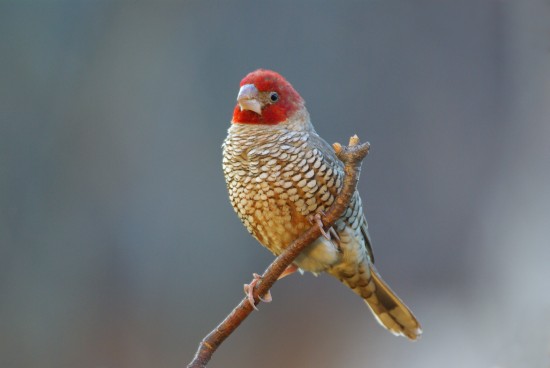


The Cut-throat finch and the Red-headed finch are the only two members of the family Amadina, a branch of the Estrildid family of exotic finches. These two birds are easy to tell apart and need to be kept separately simply because they can cross breed with one another. These cross breeds can be fertile and can be recognised as they have the red head colouration of the Red-headed finch but the colour is the brighter red f the Cut-throat’s band of throat feathers.
Both of these species of birds are seed eaters who will be happy with a good foreign finch seed mix, millet spray and will also enjoy green food, egg food, insect paste and sprouted seed. Grit or bird sand should be on offer at all times.
The Cut-throat (Amadina fasciata) is a common bird through Africa and is easy to see where its name comes from – the bright red band across the throat. The remainder of the bird’s plumage is pale, sandy brown with small black flecks across all of the feathers, a black-brown tail and chestnut brown belly.
They are typically around 12-13cm in length and are easily sexed, as the hen does not have the red throat band. There are several mutations that have been bred in captivity including birds with a yellow band in the place of the red, ino birds and Isabel or pastel birds.
In the wild, they live across central, eastern, western and parts of southern Africa but are hardy birds that have acclimatised well to the British climate. They rarely need addition heat and will be happy with a protected, frost free night shelter. They can live in a large breeding cage but are better in a large indoor aviary or an outside one and are active birds that will be found across all the areas of their home.
These birds have a reputation for being aggressive when they are breeding and are often kept away from the smaller, more delicate species at this time. If they live with others of the same species or of similar size, they get along fine outside of breeding season but when going to nest, can be advisable to remove from the aviary into breeding cages.
Cut-throats are particularly prone to becoming egg bound due to a calcium deficiency. Therefore, to help avoid this problem, as well as access to grit and bird sand, it is often advisable to add liquid calcium to their water. This helps replace the calcium the hen uses when making an egg and means she can produce a stronger egg that can be passed without complications. The size of the egg to the size of the bird is another factor as these two species both lay large sized eggs.
They will nest in half open finch boxes or even build a nest in a basket style nest. Typical preferred size of nesting box I around 4x5 inches with a height of around 6 inches. They lay 4-6 eggs that are incubated by both birds until they hatch at around 12-14 days. They fledge at around a month old but are fed by the parents for around another two weeks after this. Adult colouration can take 3-4 months to be complete.
The Red-headed finch (Amadina erythrocephala) is also known as the Paradise Finch or the Red Head Weaver and is found in Angola, Botswana, Lesotho, Namibia, South Africa and Zimbabwe across Southern Africa.
These birds can easily be sexed as the male bird has bright red head feathers that are missing on the female. The chest is dark brown with white spots while the wings and back are lighter brown with some white marking. They tend to be around 13cm in length so are generally slightly larger than their cut-throat cousins are.
Of the two birds in this family, the Red-headed is the more sociable. It doesn’t have the reputation of the cut-throat for being aggressive during breeding season so can be housed all year round with other birds. You can also keep a number of pairs of the same birds together without any problems and they will live happily in a colony system.
They are a calm species generally who will go about their business without too much fuss. However, they can be a little nervous when nesting so avoid nest inspections and disturbing them as much as possible to avoid abandoned nests.
They enjoy a large outdoor aviary or a large indoor one rather than a breeding cage and like to have greenery around their home. They are quite hardy to our climate so don’t need any special requirements apart from a frost-free night house to shelter in during the coldest times.
Red-headed finches aren’t the best nest builders and will usually utilise one that has already been made, or a finch nest box with some lining already in place. When they do build, it tends to be a globular nest with a tunnel entrance and has strands sticking out which looks messy but is actually a deterrent for animals peering in.
Both of the birds do the incubating of 4-8 eggs and calcium depletion can be a problem for this bird that is understandable when the size of the egg to the bird is seen. The chicks hatch after 13-14 days and fledge at around 3 weeks, being independent in a further 2-3 weeks.
Red headed male finches are known for their mimicking abilities, which are quite rare in finches. One particular breeder stated that his was such a good mimic; it could even say its own name!
Both of these species have a few requirements but generally are easy enough to cater for and the Red-headed in particular can make a pleasant and eye-catching addition to the aviary. Keep an eye out for egg-binding problems by supplementing diet with plenty of calcium rich grit and sand and hopefully they will be laying their eggs and producing plentiful chicks in no time at all.
Copyright © 2005-2016 Pet Information All Rights Reserved
Contact us: www162date@outlook.com